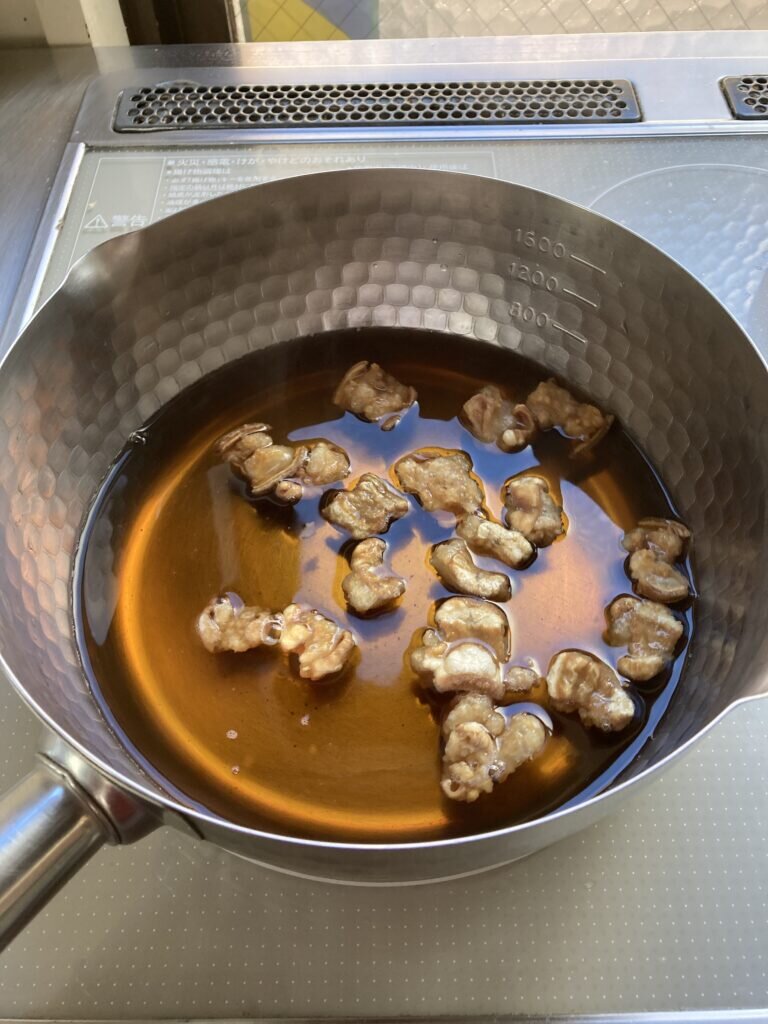
When thinking of Osaka food, takoyaki, okonomiyaki and kushikatsu are the first dishes that springs to mind. However, one speciality that often goes under the radar is Kasu Udon. I will introduce how to make Osaka udon.
Table of Contents
What is Udon?
Udon is a wheat flour noodle, which is thicker in size compared to ramen noodles. As a result, the wheat flour gives the noodles a chewy but light texture. Udon dishes are commonly served hot with a soup containing dashi, soy sauce and mirin, called kake udon. In addition, there are a variety of toppings to serve with. The most common being spring onions, tempura and deep fried tofu (aburaage).
However, if you are thinking about eating udon in the summer, there are various cold udon dishes available. The first is zaru udon, which is cold udon noodles with a dipping sauce. You dip the noodles in the sauce along with a variety of toppings like wasabi and ginger. Another popular dish is bukkake udon, which is cold udon noodles served in a thicker dashi broth.
There are many ways to enjoy hot udon and Osaka’s style is through using horumon.
What is Osaka style Kasu Udon?
The word ‘kasu’ means ‘leftovers’ but not in the way we usually think. Leftover cow’s small intestines are deep fried so water and excess fat inside is removed. This intensifies the umami flavour of the beef hormones. These fried intestines are then combined with Kansai’s style of light kombu dashi. The umami flavour and oil slowly dissolves into the dashi, creating a delightful broth. This broth is then placed in a bowl of udon and topped with the beef intestines and various toppings.
History of Kasu Udon
Kasu udon was originated in the southern Kawachi region of Osaka. It is said to have been created in Noodle Kui Yama-chan shop in 1995. Much like horumonyaki (You can read about my guide to making horumon karaage here!), leftover intestines were not wasted. They were deep fried to intensify in flavour. Consequently, the umami packed udon dish gained popularity throughout Osaka.
Many people mistake kasu udon for tenkasu, which is tempura scraps. This is a common topping for udon dishes and, while it is true to the name, Osaka kasu udon uses beef hormone. Amongst locals in southern Osaka, kasu udon is eaten with alcohol. The oily, umami packed but light broth pairs well with a glass of beer.
How to Make Dashi
I could write a whole article about dashi as it is one of the staples of Japanese cuisine. It is the base of many of the nation’s favourite dishes such as miso soup, ramen and shabu shabu. Therefore to simplify, the most common dashi is made from kombu (dried kelp). This is the most simple dashi you can make and is also vegetarian friendly. The nutiritional and umami packed flavour kombu offers is unlike any seaweed in the world. Another key point is that it contains glutamic and amino acids, created an umami flavour. You may recognise these words from MSG, an artificial form of umami. As a result, kombu has naturally packed umami flavours.
You can watch a video on how to make Kombu dashi here.
Ingredients
Water 1000ml
Kombu 13g
Method
1.Cut the kombu into pieces that will fit into your saucepan. Most importantly, do not wipe any of the white powder off the kombu as that is packed with umami.


2. Place the cold water in the pan and add the kombu.

2. Slowly bring up the heat to around 65 to 70 degrees celsius. Keep at this temperature for around 1 hour.

3. After 1 hour, remove the kombu. Boil once and remove any foam (scum) with a ladle. Pass through a collinder and you will be left with kombu dashi.

If you are looking for a quicker dashi, you can keep add a bit more kombu and keep at 65 degrees celsius for 10 minutes. After, you can take out the kombu and use as it is.
If you can not find kombu, you may be able to find dashi powder. Dashi powder is a convenient way to get the umami flavour of dashi without all the hassle of making it. One of the best dashi packs is Kayanoya dashi pack, which is in my experience, the tastiest one. To use instant dashi, you put the specified of powder in a pan with hot water and mix. It’s so simple and it’s not as good as making it yourself but it is very close.
You will find various types of dashi such as shiitake and dried anchovy, however kombu is the most common.


How to Make Osaka Udon
Ingredients
Kombu Dashi 300ml
Soy Sauce 2tbsp
Mirin 2tbsp
Kasu 100g*
Udon 1 packet
Vegetable oil
Spring onions (optional)
Method
- While deep frying, prepare your dashi. If you have not already made your kombu dashi, you can start making it now, using my method mentioned above.

2. Heat the dashi gently and add the soy sauce and mirin. Bring to a near boil and add the kasu and heat for 1 minute. You should be able to see some of the oil leaking into the dashi.


3. In a separate saucepan, boil the udon according to the instructions on the packet.


4. Drain the udon and rinse slightly with cold water. Place the udon in the bowl and gently pour over the dashi. Finish with the kasu and any additional toppings.*


Notes
*Kasu is quite hard to find. I bought my kasu from Amazon.
*You can buy the pre cooked packets of udon or the unboiled packets at most asian supermarkets. Follow the instructions on the back of the packet for how to prepare your udon.
*The great thing about udon is that you can put anything you want on top! Leftover vegetables or meat are a great topping!
(You can watch a video on how to make kasu udon down below!)
Toppings
Green onion
Spring onions are a common topping for udon dishes. The bright green colour contrasts well with the dark soup. Furthermore, it offers a nice crunch to balance the chewiness of the noodles.

Seven Spice powder (Shichimi)
Shichimi consists of seven (shichi in Japanese) different flavours mixed to create one. It contains: chilli flakes, sansho (sichuan pepper), sesame seeds, seaweed, shiso, dried mandarin and poppy seeds. The most popular brand is Yawataya Isogoro Shichimi Togarashi and can be found in asian supermarkets or on amazon.
Another alternative is ichimi, which consists of just red chilli flakes.

Tempura
Tempura is one of the staple dishes in Japan. It is a light batter, which is extremely crunchy, yet easy to eat. Vegetables and seafood are most commonly found in tempura dishes. Personal favourites are sweet potato, pumpkin and prawn. These are great toppings to udon dishes and would be a nice addition to kasu udon if you are looking for a heartier meal.

Tempura Scraps Tenkasu
Tenkasu are small scraps of batter made from tempura. It offers another crunchy texture to help balance the udon dish. Tenkasu can be found in most asian supermarkets.

Onsen Tamago
Onsen tamago directly translates to hotspring egg. Originally, eggs were gently poached in onsen water to create a soft and silky egg white with a runny yolk. It’s a creamy texture and when paired with udon, it gives the broth an added richness. One of my personal favourite toppings!
Grated radish
Daikon is a type of radish, which is milder in flavour and less peppery. When grated is a has a refreshing taste as well as being a little sweet. Paired with udon, it makes the dish lighter and refreshing. Usually it is paired with cold bukkake udon, however you can pair it with a hot udon dish.

Where to Enjoy Kasu Udon
Noodle Kui Yama-chan
This is the said birthplace of kasu udon so it is a must visit. It is located near Sakaihigashi station about 10 minutes by walking. There are only 8 seats available, all of which are counter top. It can be quite busy at times but it is worth the wait. If you are worried about what to order, there is a blackboard showing which dishes are the most popular.
They use 100% domestic wheat, creating a bouncy and chewy texture for the udon. Furthermore, they have various toppings such as egg, spring onions and spices. One of their specialities is the kasu curry udon, which has a thick and rich flavour.
Address: Osaka, Sakai-shi, Ichijodori 16-24
Telephone: 072-238-8883
Business Hours: 11:30-14:00 (LO) and 18:00-20:00 (LO)
Ryu-nosu Shinsaibashi Mitsutera
Ryo-nosu specialises in yakiniku horumon that also serves kasu udon. It was mainly on the side menu but it grew in popularity with the customers and the owner. He started to develop his own signature kasu udon, using the freshest horumon available. This is quite unique feature of the restaurant as usually udon is not available in hourmon yakiniku restaurants. The most popular kasu udon is their ‘stamina kasu-udon’. The addition of eggs, beef ribs and garlic adds more nutrition and creates a hearty meal for anyone.
Address: Osaka, Chuo-ku Shinsaibashi-Suji 2-7-11 Nippou Royal Building 1F
Telephone: 06-6212-6131
Business Hours: 18:00-6:00am the next day
Udon Motsunabe Kichi
The are two stores running, both of which are around Ishibashi station. The main feature of this udon shop is their noodles, which are thinner than normal and have a strong elasticity to them. In addition, their dashi is made from Hokkaido kombu with a mixture of sardines, auxis fish, mackarel and bonito. It has an incredible depth of flavour, whilst also being extremely light. Kasu is an additional topping so you can enjoy it with any udon.
Address: Osaka, Ikeda-shi, 1-11-13
Telephone: 06-6212-6131
Business Hours: 11:00-15:00 and 17:30-22:00
Udon Dojo Tanimachi Store
Udon Dojo is easily accessible being just 3 minutes from Tanimachi 6-chome station. The noodles are thinner than normal udon but are translucent so that your chopsticks can be seen through them! They are firm in texture while being smooth and easy to eat. There are only 10 counter seats and has a nice warm charm to it.
One of their top recommendations yuzu kasu udon. It comes with a wedge of yuzu, with the aroma spreading throughout the store as it is brought to your seat. The freshness of the yuzu with the umami packed soup and udon is the perfect balance.
Address: Osaka, Chuo-ku, Umeachi 1-26-9, Fuji Building 1F
Telephone: 06-6763-0141
Business Hours: 11:00-15:00 and 18:00-01:00
Final
This was my first making kasu udon, however it turned out very well! The kasu addition adds a great umami flavour and unique flavour compared to a regular bowl of udon. I can see why people in Osaka love this dish. The lightness of the broth with the umami packed kasu is perfect for a light meal or dinner.






















Kasu (beef small intestines) is an easy find in America. No need for overpriced Amazon. Avoid the wait time and just go to any Mexican market with a butcher (Vallarta, Super Foods, or any smaller mom & pop ethnic market). Mexicans love to eat guts, and their butchers are experts at cleaning and preparing them to be cooked and eaten.
Once upon a time the role of ‘gut & offal master’ was reserved for your local Italian, German, Slavic, or Asian meat market butcher. Bu alas, they have fled to the suburbs and their children have become 100% boring Americans with way too unadventurous taste-buds. So, go for the Mexican markets for any cut of meat that you can’t find at the Whole Foods.